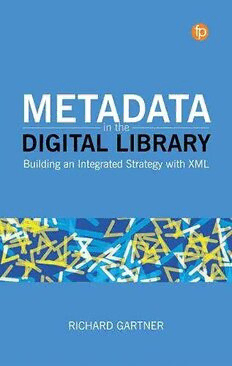
Metadata in the Digital Library: Building an Integrated Strategy with XML PDF
Preview Metadata in the Digital Library: Building an Integrated Strategy with XML
Praise for Metadata in the Digital Library ‘Gartner’s latest book is written with his characteristic clarity and authority. He defines the concepts of metadata in an engaging and natural way and his book bridges the gap between theory and practice by using examples from his own work at the Warburg Institute Library. He has taken a fresh approach to explaining how XML works, as well as widely used metadata standards such as Dublin Core and METS. The chapters on Metadata Management (Chapter 3) and the Semantic Web (Chapter 10) are particularly informative. This quality of writing comes from a deep understanding of the subject coupled with direct experience of day-to-day management and use of metadata. Metadata in the Digital Library will be a valuable resource for postgraduate students studying information and knowledge organisation at our University.’ Dr David Haynes, School of Computing, Edinburgh Napier University ‘This book is a fantastic blend of technical detail, disciplinary expertise and introductory information. A general description and discussion about metadata contextualises more detailed analyses of good practice guidelines for creating interoperable metadata. While the book is most relevant to digital libraries, the concepts and standards discussed are relevant across the GLAM sector. Readers new to the adventures of metadata for digital collections will feel challenged (in the best possible way) and experts will have an authoritative reference they can use to support their work. I thoroughly enjoyed reading this book and plan on adding it to my modules’ core reading lists.’ Kristen Schuster, Lecturer in Digital Curation, King’s College London Metadata in the Digital Library Every purchase of a Facet book helps to fund CILIP’s advocacy, awareness and accreditation programmes for information professionals. Metadata in the Digital Library Building an Integrated Strategy with XML Richard Gartner Contents Figures and tables xi Acknowledgements xiii List of abbreviations xv 1 Introduction, Aims and Definitions 1 1.1 Origins 1 1.2 From information science to libraries 2 1.3 The central place of metadata 4 1.4 The book in outline 6 2 Metadata Basics 9 2.1 Introduction 9 2.2 Three types of metadata 10 2.2.1 Descriptive metadata 10 2.2.2 Administrative metadata 14 2.2.3 Structural metadata 18 2.3 The core components of metadata 19 2.3.1 Syntax 19 2.3.2 Semantics 20 2.3.3 Content rules 21 2.4 Metadata standards 23 2.5 Conclusion 23 3 Planning a Metadata Strategy: Basic Principles 25 3.1 Introduction 25 3.2 Principle 1: Support all stages of the digital curation 25 lifecycle 3.3 Principle 2: Support the long-term preservation of 27 the digital object 3.4 Principle 3: Ensure interoperability 29 3.5 Principle 4: Control metadata content wherever possible 30 3.6 Principle 5: Ensure software independence 31 viii METADATA IN THE DIGITAL LIBRARY 3.7 Principle 6: Impose a logical system of identifiers 32 3.8 Principle 7: Use standards whenever possible 32 3.9 Principle 8: Ensure the integrity of the metadata itself 33 3.10 Summary: the basic principles of a metadata strategy 34 4 Planning a Metadata Strategy: Applying the Basic 37 Principles 4.1 Introduction 37 4.2 Initial steps: standards as a foundation 37 4.2.1 ‘Off-the shelf’ standards 38 4.2.2 Mapping out an architecture and serialising it 40 into a standard 4.2.3 Devising a local metadata scheme 43 4.2.4 How standards support the basic principles 45 4.3 Identifiers: everything in its place 45 5 XML: The Syntactical Foundation of Metadata 53 5.1 Introduction 53 5.2 What XML looks like 54 5.3 XML schemas 56 5.4 Namespaces 57 5.5 Creating and editing XML 60 5.6 Transforming XML 62 5.7 Why use XML? 65 6 METS: The Metadata Package 67 6.1 Introduction 67 6.2 Why use METS? 67 6.3 The METS architecture 69 6.4 Identifiers within METS 70 6.5 The METS root element 71 6.6 The METS Header 72 6.7 Descriptive Metadata Section 73 6.8 Administrative Metadata Section 74 6.9 The File Section 77 6.10 The Structural Map 82 6.11 Structural Links and Behavior Section 85 6.12 Creating and using METS in practice 87 7 Descriptive Metadata: Semantics 89 7.1 Introduction 89 7.2 Dublin Core 89 CONTENTS ix 7.3 MODS – the Metadata Object Description Schema 93 7.4 MARCXML 99 7.5 Other descriptive metadata standards 101 7.5.1 VRA Core 102 7.5.2 Text Encoding Initiative P5 Manuscript Description 102 7.5.3 Schemas from the sciences and social sciences 103 7.5.4 Using these schemas 103 7.6 Descriptive metadata: from semantics to content rules 104 8 Descriptive Metadata: Content Rules 105 8.1 Introduction 105 8.2 Why content rules are needed 105 8.3 Cataloguing rules 107 8.3.1 Established standards for cataloguing rules 108 8.4 Devising local guidelines 110 8.5 Controlled vocabularies 117 8.5.1 Name authorities 118 8.5.2 Subjects 121 8.5.3 Codes and dates 123 8.6 Creating local name authorities and thesauri: the 124 MADS schema 9 Administrative and Preservation Metadata 127 9.1 Introduction 127 9.2 PREMIS: an overview 129 9.2.1 Technical metadata: the PREMIS Object entity 130 9.2.2 Digital provenance metadata: the PREMIS Event 133 and Agent entities 9.2.3 Rights metadata: the PREMIS Rights entity 136 9.2.4 Using PREMIS with METS 138 9.3 Other useful schemas for administrative metadata 139 9.3.1 Technical metadata 139 9.3.2 Rights metadata 143 9.4 How much administrative metadata do we need? 145 10 Pathways to Interoperability 147 10.1 Introduction 147 10.2 Exchanging METS files 148 10.3 Metadata harvesting 151 10.4 The Semantic Web 153 10.5 Conclusion 157
